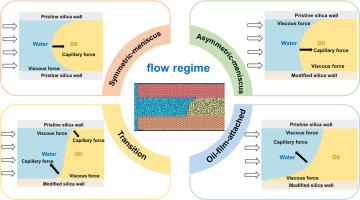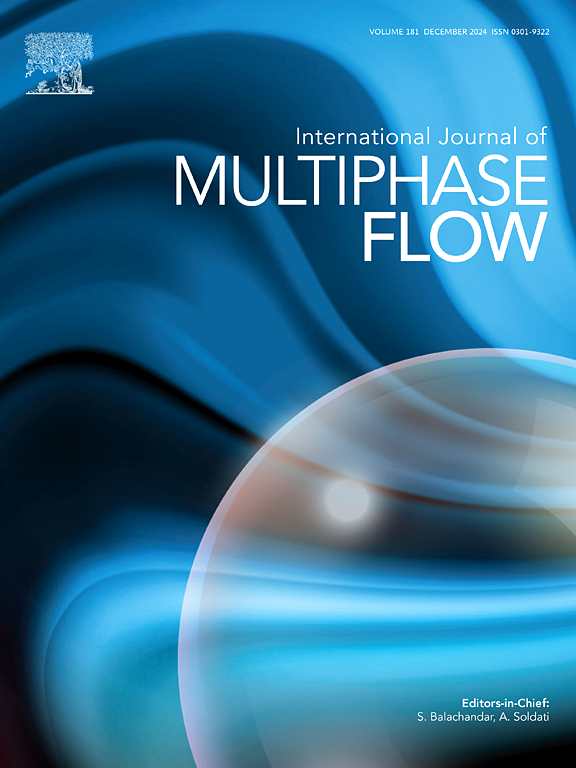非均质纳米通道中依赖于表面润湿性的水驱油两相流
IF 3.8
2区 工程技术
Q1 MECHANICS
International Journal of Multiphase Flow
Pub Date : 2025-09-05
DOI:10.1016/j.ijmultiphaseflow.2025.105441
引用次数: 0
摘要
对于纳米通道中油水两相流动过程,表面油水润湿性对流动特性有显著影响。当上下表面的润湿性不同时,沟道内部会发生许多有趣的现象,但尚未有研究报道。本研究利用分子动力学模拟方法研究了非均质纳米通道中水驱油两相流动,并与已建立的理论模型进行了比较。当一面壁面由亲水性演变为疏水性,而另一面壁面仍为亲水性时,流动状态依次从对称半月板、不对称半月板、过渡到油膜附着流动,并随着通道高度和驱动压力的变化而变化。流量表现出非线性依赖于驱动压力的变化,在不同的制度。与用于预测均匀通道中随时间变化的吸胀长度的理论模型相比,在非对称半月板、过渡和油膜附着状态下,由于非均匀毛管力和油膜附着产生的额外阻力,观察到相当大的偏差。本文章由计算机程序翻译,如有差异,请以英文原文为准。

Surface-wettability dependent water-driving-oil two-phase flow in heterogeneous nanochannels
For the oil-water two-phase flow process in nanochannels, the oil-water wettability of the surface has a significant impact on the flow characteristics. When the wettabilities of the upper and lower surfaces are different, many interesting phenomena occur inside the channels, but no studies have been reported. This work investigates water-driving-oil two-phase flow in heterogeneous nanochannels using molecular dynamics simulations coupled with comparisons to a well-established theoretical model. As one wall evolves from hydrophilic to hydrophobic while the opposite remains hydrophilic, the flow regime sequentially evolves from symmetric-meniscus, asymmetric-meniscus, transition, to oil-film-attached flow, with variations depending on channel height and driving pressure. Flow rates exhibit nonlinear dependence on driving pressure with variations across regimes. Comparing with the theoretical model developed for predicting the time-varying imbibition length in homogeneous channels, considerable deviations are observed in asymmetric-meniscus, transition, and oil-film-attached regimes owing to additional resistances arising from heterogeneous capillary forces and oil-film adhesion.
求助全文
通过发布文献求助,成功后即可免费获取论文全文。
去求助
来源期刊
CiteScore
7.30
自引率
10.50%
发文量
244
审稿时长
4 months
期刊介绍:
The International Journal of Multiphase Flow publishes analytical, numerical and experimental articles of lasting interest. The scope of the journal includes all aspects of mass, momentum and energy exchange phenomena among different phases such as occur in disperse flows, gas–liquid and liquid–liquid flows, flows in porous media, boiling, granular flows and others.
The journal publishes full papers, brief communications and conference announcements.

 求助内容:
求助内容: 应助结果提醒方式:
应助结果提醒方式:


